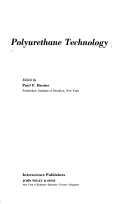Suggested Text Books
Below is a list of suggested text books on polyurethane technology with emphasis placed on cast urethane elastomers. They should be available through your local public library via the inter-library load service. These texts should be useful for anyone entering the field or experienced technologists or sale/marketing personnel seeking a deeper understanding of urethane technology. Use the find function on your browser to search for keywords (CTRL+F on a PC, CMD+F on a Mac.)
Suggest a resource for the Virtual Technical Library
The Polyurethanes Book

David Randall (Editor), Steve Lee (Editor)
Publication Date: May 15, 2003
ISBN: 978-0470850411 | Edition: 1
Since the first Polyurethanes book was published in 1987, and reprinted with updates in 1990, the world of polyurethanes has changed dramatically. This edition has been completely re-structured, re-written and enlarged by approximately 50%. It provides a greater focus on the whole range of components used to produce polyurethanes, a more detailed analysis of environmental issues and extended views on the applications for polyurethanes.
Castable Polyurethane Elastomers

I.R. Clemitson (Author)
Publication Date: May 13, 2008
ISBN: 978-1420065763 | Edition: 1
Castable Polyurethane Elastomers explains the production process of polyurethane components from both the theoretical and practical point of view. It describes the underlying concepts for the raw material supplier recommendations and explains how to achieve application-specific properties in polyurethane. The book explains the production of prepolymers with special focus on health and safety issues. It presents the different types of methods available on both the micro and macro levels and explains the rationale behind choosing the system needed to create a cost-effective, application-specific product.
Offering an inside look at the logic behind the formation of polyurethane components, Castable Polyurethane Elastomers enables materials scientists, engineers, and chemists to understand the total production process and reproduce the procedures to achieve desired results.
Polyurethane Elastomers: From Morphology to Mechanical Aspects

Cristina Prisacariu (Author)
Publication Date: July 8, 2011
ISBN: 978-3709105139 | Edition: 1
A comprehensive account of the physical / mechanical behaviour of polyurethanes (PU´s) elastomers, films and blends of variable crystallinity. Aspects covered include the elasticity and inelasticity of amorphous to crystalline PUs, in relation to their sensitivity to chemical and physical structure. A study is made of how aspects of the constitutive responses of PUs vary with composition: the polyaddition procedure, the hard segment, soft segment and chain extender (diols and diamines) are varied systematically in a large number of systems of model and novel crosslinked andthermoplastic PUs. Results will be related to: microstructural changes, on the basis of evidence from x-ray scattering (SAXS and WAXS), and also dynamic mechanical analyses (DMA), differential scanning calorimetry (DSC) and IR dichroism.
Understanding the reaction pathways involved, in resolving the subtle morphological evolution at the nanometre level, and capturing mathematically the complex, large-deformation nonlinear viscoelastic mechanical behaviour are assumed to bring new important insights in the world basic research in polyurethanes and towards applied industrial research in this area.
The ICI Polyurethanes Book

George Woods (Author)
Publication Date: November 1990
ISBN: 978-0471926580 | Edition: 2
User-friendly, even for those with limited knowledge of chemistry, it contains clear details of processing, applications, and safety. New to this edition is an appendix covering the considerable progress that has taken place since 1987, including the development of alternatives for chlorofluorocarbons (CFCs) and the advent of polyurea elastomers.
Polyurethanes in Biomedical Applications

Nina M.K. Lamba (Author), Kimberly A. Woodhouse (Author), Stuart L. Cooper (Author)
Publication Date: November 25, 1997
ISBN: 978-0849345173 | Edition: Upd Sub
Polyurethanes in Biomedical Applications studies the use of polyurethanes in implanted medical devices. This analysis describes the concepts of polymer science, the manufacture of polyurethanes, and the biological responses to implant polyurethanes, reflecting the developments in biomaterials science and the interdisciplinary nature of bioengineering.
Polyurethane Shape Memory Polymers

W.M. Huang (Author), Bin Yang (Author), Yong Qing Fu (Author)
Publication Date: September 8, 2011
ISBN: 978-1439838006 | Edition: 1
Shape memory polymers (SMPs) are some of the most important and valuable engineering materials developed in the last 25 years. These fascinating materials demonstrate remarkably versatile properties—including capacity for actuation and stimulus responsiveness—that are enabling technologists to develop applications used to explore everything from the outer reaches of space to the inside of the human body.
A must-have reference for anyone working in the materials science and engineering fields, this book outlines the properties—such as light weight, low cost, and ability to handle high strain—that make the easily processed SMPs so useful in fields including aerospace, biomedicine, and textiles. It is intended to help readers understand and apply the knowledge and techniques presented to develop new innovations that will further benefit society.
Advances in Urethane Science and Technology

Kurt C. Frisch (Author), Daniel Klempner (Author)
Publication Date: March 29, 1992
ISBN: 9780877629702 | Edition: 1
This is the first volume in the highly regarded Advances in Urethane Science and Technology series to be published by Rapra. This book presents reports on state of the art developments in the field of urethane science, written by experts in their field. The reports in this book are highly technical with an emphasis on industrial applications. This book will be invaluable to researchers and anyone involved with producing or using urethanes.
Polyurethane Technology

Paul F. Bruins (Author)
Publication Date: 1969
ISBN: 0470113952 9780470113950 | Edition: 1
Polyurethanes: Chemistry, technology and properties

Leslie Nathan Phillips (Author), Derek Brian Valentine Parker (Author)
Publication Date: 1964
ISBN: | Edition: 1
Szycher's Handbook of Polyurethanes

Michael Szycher Ph.D (Author)
Publication Date: July 13, 2012
ISBN: 978-1439839584 | Edition: 2
A practical handbook rather than merely a chemistry reference, Szycher's Handbook of Polyurethanes, Second Edition offers an easy-to-follow compilation of crucial new information on polyurethane technology, which is irreplaceable in a wide range of applications. This new edition of a bestseller is an invaluable reference for technologists, marketers, suppliers, and academicians who require cutting-edge, commercially valuable data on the most advanced uses for polyurethane, one of the most important and complex specialty polymers.
With seven entirely new chapters and five that are revised and updated, this book summarizes vital contents from U.S. patent literature—one of the most comprehensive sources of up-to-date technical information. These patents illustrate the most useful technology discovered by corporations, universities, and independent inventors. Because of the wealth of information they contain, this handbook features many full-text patents, which are carefully selected to best illustrate the complex principles involved in polyurethane chemistry and technology.
Handbook of Fillers, Extenders, and Diluents

Michael Ash (Author), Michael and Irene Ash (Editor)
Publication Date: April 30, 2007
ISBN: 978-1890595968 | Edition: 2
This is the first update of this important reference in nine years. It describes more than 3000 trade names, generic chemicals, and materials that serve the dual functions of lowering the overall cost and improving the effectiveness of the end products to which they are added. The distinction between fillers, extenders, and diluents varies from industry to industry. In the paper industry, they are used to improve brightness, increase opacity, and reduce porosity. In paints, often referred to as inerts, extenders, and supplemental pigments, they are used to increase color, hiding power, weatherability, and control viscosity. Fillers in plastics and polymers impart impact strength, lubricity, electrical, and thermal properties. Diluents, besides supplying bulk to detergents, cosmetics, and pharmaceuticals, act to adjust dose or concentration. In general, they share essential commercial functions - increasing the bulk weight of products, diluting expensive materials, and/or acting as delivery systems for active ingredients. This group of products, therefore, is treated in this single reference source.
Chemistry and Technology of Polyols for Polyurethanes

Mihail Ionescu (Author)
Publication Date: 2005
ISBN: 1-85957-491-2
Polyurethanes have become one of the most dynamic groups of polymers and they find use in nearly every aspect of modern life, in applications such as furniture, bedding, seating and instrument panels for cars, shoe soles, thermoinsulation, carpet backings, packaging, and as coatings.
The main raw materials used for the production of polyurethanes are polyols, isocyanates and propylene oxide. The first of these is the subject of the latest Rapra Handbook: Chemistry and Technology of Polyols for Polyurethanes.
This book considers the raw materials used to build the polyurethane polymeric architecture. It covers the chemistry and technology of oligo-polyol fabrication, the characteristics of the various oligo-polyol families and the effects of the oligo-polyol structure on the properties of the resulting polyurethane. It presents the details of oligo-polyol synthesis, and explains the chemical and physico-chemical subtleties of oligo-polyol fabrication.

